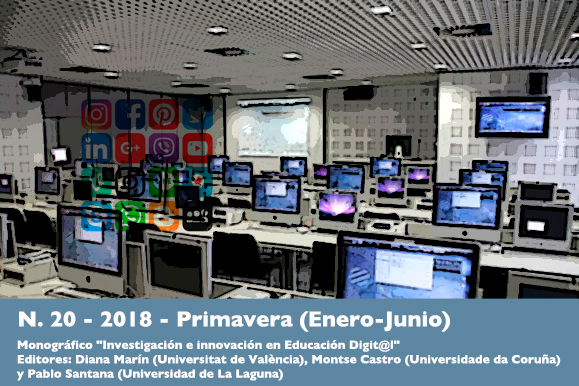Diseño de programaciones cortas para futuros profesores de Inglés en España
DOI:
https://doi.org/10.7203/attic.20.9592Palabras clave:
era post-método, diseño curricular, programación didáctica, enseñanza de inglés, España Resumen
Resumen
En este artículo se describe el proceso para que los futuros profesores de lenguas extranjeras (inglés) de Educación Secundaria aprendan a diseñar programaciones didácticas adaptadas al contexto español, según la ley educativa más reciente (LOMCE). Considerando la multitud de propuestas de métodos de enseñanza desde principios del siglo XX, y las continuas reformas educativas en España, los futuros profesionales de la enseñanza deben adquirir las competencias y habilidades necesarias para el desarrollo de programaciones que se adapten a las diferentes leyes, al mismo tiempo que se incrementa su autoestima y maestría en el aula.
 Citas
Citas
Ahmadian, M., and Rad, S.E. (2014). Postmethod era and glocalized language curriculum development: A fresh burden on language teachers. Journal of Language Teaching and Research, 5(3), 592-598. https://doi.org/10.4304/jltr.5.3.592-598
Bachman, L. F. (1990) Fundamental considerations in language testing. Oxford: Oxford University Press.
Bolívar, A., and Domingo, J. (2006). The professional identity of secondary school teachers in Spain crisis and reconstruction. Theory and Research in Education, 4(3), 339-355. https://doi.org/10.1177/1477878506069105
Brumfit, C. J. (1984). Function and structure of a state school syllabus for learners of second or foreign language with heterogeneous needs. In C.J. Brumfit (ed.). General English syllabus design. Oxford: Pergamon Press, pp. 75-82.
Can, N. (2012). Post-method pedagogy: Teacher growth behind walls. Proceedings of the 10th METU ELT Convention. Available at: http://dbe.metu.edu.tr/convention/proceedingsweb/Pedagogy.pdf (Accessed: 8/10/2014)
Canale, M. (1983). From communicative competence to communicative language pedagogy’. Language and Communication, 1, 1-47.
Chomsky, N. (1965) Aspects of the theory of syntax. Special technical report. Research laboratory of electronics. Cambridge: Massachusetts Institute of Technology (11).
Council of Europe (2001) Common European framework of reference for language learning, teaching and assessment. Cambridge: Cambridge University Press.
Cummins, J. (1979). Linguistic interdependence and the educational development of bilingual children. Review of Educational Research, 49(2), 222-251. https://doi.org/10.3102/00346543049002222
Ehrman, M. E., Leaver, B.L. and Oxford, R. (2003). A brief overview of individual differences in second language learning. System, 31(3), 313-330. https://doi.org/10.1016/S0346-251X(03)00045-9
Farrell, C. (2002). Lesson planning. In J.C. Richards and W.A. Renandya (eds.) Methodology in language teaching: An anthology of current practice. Cambridge: Cambridge University Press, pp. 30-39. https://doi.org/10.1017/CBO9780511667190
Fullan, M. (2007) The new meaning of educational change. New York: Routledge.
Graves, K. (2016). Language curriculum design: possibilities and realities. In G. Hall (Ed.). The Routledge handbook of English language teaching. London & New York: Routledge, pp 79-94.
Hadley, G. (1998) Examining the underlying principles of EFL syllabus design. 敬和学園大学研究紀要, 7, 211-228.
Hall, G. (2016). Method, methods and methodology: historical trends and current debates. In G. Hall (ed.). The Routledge handbook of English language teaching. London & New York: Routledge, pp. 209-223.
Hashemi, S. M. R. (2011). (Post)-Methodism: Possibility of the Impossible?’. Journal of Language Teaching & Research, 2(1), 137-145. https://doi.org/10.4304/jltr.2.1.137-145
Hymes, D. (1967). Models of the interaction of language and social setting. Journal of Social Issues, 23(2), 8-28. https://doi.org/10.1111/j.1540-4560.1967.tb00572.x
Kearsley, G. and Lynch, W. (1996). Structural issues in distance education. Journal of Education for Business, 71(4), 191-6. https://doi.org/10.1080/08832323.1996.10116783
Kumaravadivelu, B. (2001). Toward a postmethod pedagogy. TESOL quarterly, 35(4), 537-560. https://doi.org/10.2307/3588427
Kumaravadivelu, B. (2002). Beyond Methods: Macrostrategies for language teaching. Yale: Yale University Press.
Kumaravadivelu, B. (2006). TESOL methods: Changing tracks, challenging trends. TESOL Quarterly, 40(1), 59-81. https://doi.org/10.2307/40264511
Luque, G. (2017). Syllabus design for pre-service English language teachers in the shifting arena of the continuous Spanish educational reforms. XXXV AESLA Conference. Languages at the crossroads: training, accreditation and context of use. Jaén, May, 4-6.
Nation, P. and Macallister, J. (2009). Language curriculum design. New York: Routledge.
Nunan, D. (1988). Syllabus design. Oxford: Oxford University Press.
Ramos, M.M. and Luque, G. (2010). A competence-based constructivist tool for evaluation. Cultura y Educación, 22(3), 329-344. https://doi.org/10.1174/113564010804932148
Richards, J.C. (2013). Curriculum approaches in language teaching: Forward, central and backward design. RELC Journal, 44(1), 5-33. https://doi.org/10.1177/0033688212473293
Richards, J.C., and Rodgers, T.S. (2014). Approaches and methods in language teaching. Cambridge: Cambridge University Press. https://doi.org/10.1017/CBO9780511667305
Skehan, P. (1996). Second language acquisition research and task-based instruction. In J. Willis and D. Willis (eds.) Challenge and change in language teaching. Oxford: Heinemann, pp. 17-30.
Smriti, K. and Jha, S.K. (2015). An overview of ELT syllabi. International Journal of Innovations in TESOL and Applied Linguistics, 1, 1-6.
Tejada, G., Perez, M.L. and Luque, G. (2006). Current approaches and teaching methods. In N. McLaren and D. Madrid (eds.). TEFL in secondary education. Granada: Servicio de publicaciones, pp. 155-209.
Tiana, A., Moya, J. and Luengo, F. (2011). Implementing key competences in basic education: reflections on curriculum design and development in Spain. European Journal of Education, 46(3), 307-322. https://doi.org/10.1111/j.1465-3435.2011.01482.x
Wang, V. and Stelson, U. (2017). Fundamentals in program development. In V. Wang (ed.) Handbook of Research on Program Development and Assessment Methodologies in K-20 Education. Hershey: IGI Global, pp. 24-48.
White, R. (1988) The ELT curriculum: Design, innovation and management. Oxford: Blackwell.
Widdowson, H.G. (1990) Aspects of language teaching. Oxford: Oxford University Press.
Willis, D., and Willis, J. (2008) Doing task-based teaching. Oxford: Oxford University Press.
Winke, P. M. (2007). The psychology of the language learner: Individual differences in second language acquisition. Studies in Second Language Acquisition, 29(1), 143-144.
Yalden, J. (1983) The communicative syllabus: Evolution, design and implementation. Oxford: Pergamon.
Descargas
Publicado
Número
Sección
Licencia
Todos los artículos de la revista, están sujetos a una licencia Creative Commons del tipo Reconocimiento - NoComercial - Sin Obra Derivada
